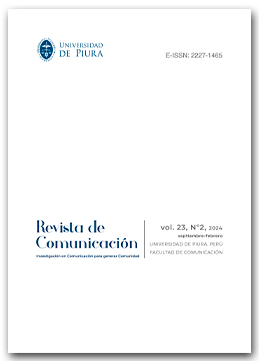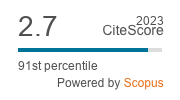Estrategias de publicación de los CEO de empresas de América Latina en LinkedIn y su impacto en el engagement
DOI:
https://doi.org/10.26441/RC23.2-2024-3592Palabras clave:
CEO, director ejecutivo, consejero delegado, comunicación digital, comunicación institucional, LinkedIn, redes sociales, compromiso, empresas, América LatinaResumen
Este estudio investiga las estrategias de publicación de los directores ejecutivos (CEO) de empresas de América Latina en LinkedIn y su impacto en el engagement. Por ello, se examinan los niveles de actividad y los tipos de presencia, así como las tasas de engagement. A partir de un análisis cuantitativo, los resultados revelan que los ejecutivos de esta región tienen una frecuencia de publicación significativamente inferior en LinkedIn en comparación con los promedios recomendados por los expertos. Respecto al tipo de presencia, los CEO son “creadores de contenido” y publican principalmente contenido propio. El análisis del engagement evidencia discrepancias entre las publicaciones propias e híbridas. Debido a la originalidad del contenido propio, este recibe mejores tasas de engagement frente a los posteos híbridos. Los hallazgos revelan que la mayoría de los CEO latinoamericanos adoptan una estrategia de publicación de “embudo pasivo” en LinkedIn, que se caracteriza por una baja actividad y contenido propio. Llama la atención que los CEO con un enfoque más pasivo tienden a obtener tasas de engagement más altas en comparación de aquellos con un enfoque más activo. A partir de aquí se desprende que, si bien el contenido auténtico genera interacción, los CEO deben aprovechar el potencial de las publicaciones compartidas, que se caracterizan por fomentar el diálogo a partir de contenidos con diversas perspectivas, rasgo particular de los actores e instituciones del entorno empresarial. Esta investigación valora el potencial de los CEO comunicadores institucionales y proporciona pautas metodológicas para académicos y profesionales encargados de las estrategias de publicación de organizaciones y directivos de la región.
Métricas
Citas
Abitbol, A., y Lee, S. Y. (2017). Messages on CSR-dedicated Facebook pages: What works and what doesn’t. Public Relations Review, 43(4), 796-808. https://doi.org/10.1016/j.pubrev.2017.05.002 DOI: https://doi.org/10.1016/j.pubrev.2017.05.002
Albanna, H., Alalwan, A. A., y Al-Emran, M. (2022). An integrated model for using social media applications in non-profit organizations. International Journal of Information Management, 63, 102452. https://doi.org/10.1016/j.ijinfomgt.2021.102452 DOI: https://doi.org/10.1016/j.ijinfomgt.2021.102452
Alghawi, I. A., Yan, J., y Wei, C. (2014). Professional or interactive: CEOs’ image strategies in the microblogging context. Computers in Human Behavior, 41, 184-189. https://doi.org/10.1016/j.chb.2014.09.027 DOI: https://doi.org/10.1016/j.chb.2014.09.027
Álvarez-Nobell, A., Molleda, J. C., Moreno, Á., Athaydes, A., Suárez-Monsalve, A. M., y Herrera, M. (2023). Latin American Communication Monitor 2022-2023. Comunicación estratégica y relaciones públicas en América Latina: Diversidad y liderazgo empático. CommTech y consultoría. Resultados de una encuesta en 20 países. https://unstats.un.org/unsd/methodology/m49/
Anderson, A. (2023). Social In The C-Suite. How CEOs are using social media to protect, develop and enhance their reputations. H/Advisors Abernathy. https://h-advisors.global/wp-content/uploads/2023/07/2023_digital-report_final.pdf
Anderson, B. D., Swenson, R., y Gilkerson, N. D. (2016). Understanding Dialogue and Engagement Through Communication Experts’ Use of Interactive Writing to Build Relationships. International Journal of Communication, 10, 4095-4118.
Apple Tree. (2024). Marcas bajo la tiranía del algoritmo.
Arevalo-Martínez, R., Bon Pereira, M. V., y Pizarro Lozano, S. K. (2018). Comunicación digital integral en las instituciones educativas con el uso de LinkedIn: estudio comparativo América Latina-Europa. Revista Latinoamericana de Ciencias de la Comunicación, 232-245. http://revista.pubalaic.org/index.php/alaic/article/view/445
Arzuaga Williams, M., Baquerizo-Neira, G., y Mena-Young, M. (2024). Evaluar y medir el impacto social de la comunicación organizacional: Perspectiva latinoamericana en un estudio global. Austral Comunicación, 13(1), 1-25. DOI: https://doi.org/10.26422/aucom.2024.1301.arz
Ballesteros Herencia, C. A. (2019). La representación digital del engagement: Revista de Comunicación, 18(1), 215-233. https://doi.org/10.26441/RC18.1-2019-A11 DOI: https://doi.org/10.26441/RC18.1-2019-A11
Beese, N. (2019). Marketing the Library using Social Media Platforms: The Experience of the University Library Bochum, Germany. International Information & Library Review, 51(1), 36-41. https://doi.org/10.1080/10572317.2019.1568778 DOI: https://doi.org/10.1080/10572317.2019.1568778
Bizz Markethink. (2022). Aprende a calcular el engagement rate en tus redes sociales. https://www.linkedin.com/pulse/aprende-calcular-el-engagement-rate-en-tus-redes-sociales-/?originalSubdomain=es
Boyd, D. M., y Ellison, N. B. (2007). Social Network Sites: Definition, History, and Scholarship. Journal of Computer-Mediated Communication, 13(1), 210-230. https://doi.org/10.1111/j.1083-6101.2007.00393.x DOI: https://doi.org/10.1111/j.1083-6101.2007.00393.x
Breen, B. (2022). The Qnary Report. Qnary. https://www.qnary.com/wp-content/uploads/2023/05/Qnary-Report-6th-Editon_FINAL.pdf
Brubaker, P. J., y Wilson, C. (2018). Let’s give them something to talk about: Global brands’ use of visual content to drive engagement and build relationships. Public Relations Review, 44(3), 342-352. https://doi.org/10.1016/j.pubrev.2018.04.010 DOI: https://doi.org/10.1016/j.pubrev.2018.04.010
Bruns, A., y Liang, Y. E. (2012). Tools and methods for capturing Twitter data during natural disasters. First Monday. https://doi.org/10.5210/fm.v17i4.3937 DOI: https://doi.org/10.5210/fm.v17i4.3937
Cabrera Cabrera, M., y Almansa-Martínez, A. (2016). El director de relaciones públicas en las grandes empresas españolas. Revista Internacional de Relaciones Públicas, VI(11), 113-134. https://doi.org/10.5783/RIRP-11-2016-07-113-134 DOI: https://doi.org/10.5783/RIRP-11-2016-07-113-134
Capriotti, P., Carretón, C., y Zeler, I. (2024). Exploring Interactivity Strategies in Social Media Communications of Leading Universities: A Cross-Continental Study. Sage Open, 14(2). https://doi.org/10.1177/21582440241259399 DOI: https://doi.org/10.1177/21582440241259399
Capriotti, P., Martínez‐Gras, R., y Zeler, I. (2023). Does universities’ posting strategy influence their social media engagement? An analysis of the top‐ranked higher education institutions in different countries. Higher Education Quarterly, 77(4), 911-931. https://doi.org/10.1111/hequ.12439 DOI: https://doi.org/10.1111/hequ.12439
Capriotti, P., Oliveira, A., y Carretón, C. (2023). A model for assessing the active presence of institutions on social media: application to universities worldwide. Journal of Marketing for Higher Education. https://doi.org/10.1080/08841241.2023.2166188 DOI: https://doi.org/10.1080/08841241.2023.2166188
Capriotti, P., y Ruesja, L. (2018). How CEOs use Twitter: A comparative analysis of Global and Latin American companies. International Journal of Information Management, 39, 242-248. https://doi.org/10.1016/j.ijinfomgt.2018.01.003 DOI: https://doi.org/10.1016/j.ijinfomgt.2018.01.003
Capriotti, P., y Zeler, I. (2020). Comparing Facebook as an interactive communication tool for companies in LatAm and worldwide. Communication & Society, 33(3), 119-136. https://doi.org/10.15581/003.33.3.119-136 DOI: https://doi.org/10.15581/003.33.3.119-136
Cho, M., Schweickart, T., y Haase, A. (2014). Public engagement with nonprofit organizations on Facebook. Public Relations Review, 40(3), 565-567. https://doi.org/10.1016/j.pubrev.2014.01.008 DOI: https://doi.org/10.1016/j.pubrev.2014.01.008
Conte, F., Siano, A., y Vollero, A. (2017). CEO communication: engagement, longevity and founder centrality. An exploratory study in Italy. Corporate Communications: An International Journal, 22(3), 273-291. https://doi.org/10.1108/CCIJ-10-2015-0062 DOI: https://doi.org/10.1108/CCIJ-10-2015-0062
Cuenca-Fontbona, J., Matilla, K., y Compte-Pujol, M. (2020). Transformación digital de los departamentos de relaciones públicas y comunicación de una muestra de empresas españolas. Revista de Comunicación, 19(1), 75-92. https://doi.org/10.26441/RC19.1-2020-A5 DOI: https://doi.org/10.26441/RC19.1-2020-A5
Da Silva Giordani, M., De Sousa Barbosa, I., y Klann, R. C. (2023). Uso de Mídia Social pelo CEOs e o Gerenciamento de Resultados. Revista de Educação e Pesquisa em Contabilidade, 17(3). https://doi.org/10.17524/repec.v17i3.3225 DOI: https://doi.org/10.17524/repec.v17i3.3225
de Fatima Oliveira, M., y Murphy, P. (2009). The leader as the face of a crisis: Philip Morris’ CEO’s speeches during the 1990s. Journal of Public Relations Research, 21(4), 361-380. https://doi.org/10.1080/10627260902966425 DOI: https://doi.org/10.1080/10627260902966425
Denner, N., Koch, T., y Senger, S. (2021). Faces of companies: Personalization of corporate coverage in crisis and non-crisis periods. Journalism, 22(11), 2747-2763. https://doi.org/10.1177/1464884920901615 DOI: https://doi.org/10.1177/1464884920901615
Dévai, D. (2022). Panel Epsilon Icarus Analytics. Estudio Top 150 CEO en LinkedIn: enero-octubre 2022.
Dévai, D., Carrillo, M., Gisbert, E., y Piqué, M. (2023). Panel Top - 190 Directores de Marketing en LinkedIn. Epsilon Technologies. https://www.epsilontec.com/los-directores-de-marketing-mas-influyentes-en-linkedin/
Dévai, D., Carrillo, M., Gisbert, E., y Piqué, M. (2024). Panel Analytics Icarus Top 227 Directores de Marketing en Linkedin. Epsilon Technologies
Dévai, D., y Peralt, A. (2022). Estudio Top 115 CEOs LinkedIn S2-2021. Epsilon Technologies. https://epsilontec.com/quienes-son-los-ceos-de-las-empresas-espanolas-que-mas-triunfan-en-linkedin/
Domínguez, A., Gardier, C., Fernández, M., Sánchez, Y., Fernández-Sesma, C., y Ortega, I. (2023). New Times, New Leadership: 3 pasos hacia el liderazgo ejecutivo. LLYC. https://bit.ly/4eYnzDW
Evans, M., Novicevic, M. M., Martin, J. S., y Dorn, F. J. (2008). CEO blogs: credibility issues. International Journal of Information Technology and Management, 7(2), 161. https://doi.org/10.1504/IJITM.2008.016603 DOI: https://doi.org/10.1504/IJITM.2008.016603
Fleck, N., Michel, G., y Zeitoun, V. (2014). Brand Personification through the Use of Spokespeople: An Exploratory Study of Ordinary Employees, CEOs, and Celebrities Featured in Advertising. Psychology & Marketing, 31(1), 84-92. https://doi.org/10.1002/mar.20677 DOI: https://doi.org/10.1002/mar.20677
Fröhlich, R., y Knobloch, A. S. (2021). “Are they allowed to do that?” Content and typology of corporate socio-political positioning on TWITTER. A study of DAX-30 companies in Germany. Public Relations Review, 47(5), 102113. https://doi.org/10.1016/j.pubrev.2021.102113 DOI: https://doi.org/10.1016/j.pubrev.2021.102113
Gaines-Ross, L. (2000). CEO Reputation: A Key Factor in Shareholder Value. Corporate Reputation Review, 3(4), 366-370. https://doi.org/10.1057/palgrave.crr.1540127 DOI: https://doi.org/10.1057/palgrave.crr.1540127
Gaines-Ross, L. (2002). CEOs Stranded in Wonderland. Journal of Business Strategy, 23(2), 18-20. https://doi.org/10.1108/eb040231 DOI: https://doi.org/10.1108/eb040231
Garavito, C. (2022). Cómo se calcula el «engagement» de una publicación en LinkedIn. https://bit.ly/4eUgdl2
Glick, M. B. (2011). The Role of Chief Executive Officer. Advances in Developing Human Resources, 13(2), 171-207. https://doi.org/10.1177/1523422311415642 DOI: https://doi.org/10.1177/1523422311415642
González Cáceres, E. (2022). Análisis del estilo de comunicación de CEOs mexicanas en la confianza organizacional de los empleados durante la pandemia por COVID-19. Revista Internacional de Relaciones Públicas, 12(24), 45-64. https://doi.org/10.5783/revrrpp.v12i24.788 DOI: https://doi.org/10.5783/revrrpp.v12i24.788
Grafström, M., y Falkman, L. L. (2017). Everyday narratives: CEO rhetoric on Twitter. Journal of Organizational Change Management, 30(3), 312-322. https://doi.org/10.1108/JOCM-10-2016-0197 DOI: https://doi.org/10.1108/JOCM-10-2016-0197
Grunig, J. E., y Grunig, L. A. (2000). Public Relations in Strategic Management and Strategic Management of Public Relations: theory and evidence from the IABC Excellence project. Journalism Studies, 1(2), 303-321. https://doi.org/10.1080/14616700050028271 DOI: https://doi.org/10.1080/14616700050028271
Heavey, C., Simsek, Z., Kyprianou, C., y Risius, M. (2020). How do strategic leaders engage with social media? A theoretical framework for research and practice. Strategic Management Journal, 41(8), 1490-1527. https://doi.org/10.1002/smj.3156 DOI: https://doi.org/10.1002/smj.3156
Huaman-Ramirez, R., y Merunka, D. (2021). Celebrity CEOs’ credibility, image of their brands and consumer materialism. Journal of Consumer Marketing, 38(6), 638-651. https://doi.org/10.1108/JCM-08-2020-4026 DOI: https://doi.org/10.1108/JCM-08-2020-4026
Huang, L. V., y Yeo, T. E. D. (2018). Tweeting #Leaders: Social media communication and retweetability of Fortune 1000 chief executive officers on Twitter. Internet Research, 28(1), 123-142. https://doi.org/10.1108/IntR-08-2016-0248 DOI: https://doi.org/10.1108/IntR-08-2016-0248
Hyland, K. (1998). Exploring Corporate Rhetoric: Metadiscourse in the CEO’s Letter. International Journal of Business Communication, 35(2), 224-244. https://doi.org/10.1177/002194369803500203 DOI: https://doi.org/10.1177/002194369803500203
Ibrahim, B., Aljarah, A., Hayat, D. T., y Lahuerta-Otero, E. (2022). Like, comment and share: examining the effect of firm-created content and user-generated content on consumer engagement. Leisure/Loisir, 46(4), 599-622. https://doi.org/10.1080/14927713.2022.2054458 DOI: https://doi.org/10.1080/14927713.2022.2054458
Jain, R., De Moya, M., y Molleda, J.-C. (2014). State of international public relations research: Narrowing the knowledge gap about the practice across borders. Public Relations Review, 40(3), 595-597. https://doi.org/10.1016/j.pubrev.2014.02.009 DOI: https://doi.org/10.1016/j.pubrev.2014.02.009
Jameson, D. A. (2014). Crossing Public-Private and Personal-Professional Boundaries: How Changes in Technology May Affect CEOs’ Communication. Business and Professional Communication Quarterly, 77(1), 7-30. https://doi.org/10.1177/2329490613517133 DOI: https://doi.org/10.1177/2329490613517133
Kemp, S. (2024). Digital 2024: Global Overview Report. Meltwater & We Are Social https://datareportal.com/reports/digital-2024-global-overview-report
Kent, M. L. (2013). Using social media dialogically: Public relations role in reviving democracy. Public Relations Review, 39(4), 337-345. https://doi.org/10.1016/j.pubrev.2013.07.024 DOI: https://doi.org/10.1016/j.pubrev.2013.07.024
Kent, M. L., y Taylor, M. (1998). Building dialogic relationships through the world wide web. Public Relations Review, 24(3), 321-334. https://doi.org/10.1016/S0363-8111(99)80143-X DOI: https://doi.org/10.1016/S0363-8111(99)80143-X
Kent, M. L., y Taylor, M. (2021). Fostering Dialogic Engagement: Toward an Architecture of Social Media for Social Change. Social Media + Society, 7(1), 205630512098446. https://doi.org/10.1177/2056305120984462 DOI: https://doi.org/10.1177/2056305120984462
Kim, T., y Sung, Y. (2021). CEOs’ self-disclosure on Instagram and consumer-brand relationships: the moderating effect of relationship norms. International Journal of Advertising, 40(6), 897-921. https://doi.org/10.1080/02650487.2020.1837485 DOI: https://doi.org/10.1080/02650487.2020.1837485
Komljenovic, J. (2019). Linkedin, platforming labour, and the new employability mandate for universities. Globalisation, Societies and Education, 17(1), 28-43. https://doi.org/10.1080/14767724.2018.1500275 DOI: https://doi.org/10.1080/14767724.2018.1500275
Lee, S. (2006). Corporate blogging strategies of the Fortune 500 companies. Management Decision, 44(3), 316-334. https://doi.org/10.1108/00251740610656232 DOI: https://doi.org/10.1108/00251740610656232
Lee, S. M., y Know Lee, C. (2002). e-Company CEO Websites: contents and information value. Management Decision, 40(2), 158-167. https://doi.org/10.1108/00251740210422839 DOI: https://doi.org/10.1108/00251740210422839
Lee, Y., y Kim, J. (2022). The impacts of CEO leadership behaviors on employees’ affective commitment and scouting behavior: the mediating role of symmetrical internal communication. Leadership and Organization Development Journal, 43(2), 261-278. https://doi.org/10.1108/LODJ-11-2020-0501 DOI: https://doi.org/10.1108/LODJ-11-2020-0501
Longenecker, C. O., y Wittmer, J. L. S. (2023). CEO lessons on workforce development and success in a global pandemic. Development and Learning in Organizations, 37(1), 15-17. https://doi.org/10.1108/DLO-01-2022-0028 DOI: https://doi.org/10.1108/DLO-01-2022-0028
Love, E. G., Lim, J., y Bednar, M. K. (2017). The Face of the Firm: The Influence of CEOs on Corporate Reputation. Academy of Management Journal, 60(4), 1462-1481. https://doi.org/10.5465/amj.2014.0862 DOI: https://doi.org/10.5465/amj.2014.0862
Macready, H., y Cohen, B. (2023). How Often to Post to Social Media in 2023. Hootsuite. https://blog.hootsuite.com/how-often-to-post-on-social-media/
Malhotra, C. K., y Malhotra, A. (2016). How CEOs Can Leverage Twitter. MIT Sloan Management Review, 57(2), 72-79. http://mitsmr.com/1QiMXWJ
Manfredi-Sánchez, J. L. (2019). Activismo político de los presidentes de empresa del IBEX 35 ante los retos políticos, sociales y medioambientales. El profesional de la informacion, 28(5). https://doi.org/10.3145/EPI.2019.SEP.05 DOI: https://doi.org/10.3145/epi.2019.sep.05
Manika, D., Papagiannidis, S., y Bourlakis, M. (2015). Can a CEO’s YouTube apology following a service failure win customers’ hearts? Technological Forecasting and Social Change, 95, 87-95. https://doi.org/10.1016/j.techfore.2013.12.021 DOI: https://doi.org/10.1016/j.techfore.2013.12.021
Marroquin Velásquez, L., Rabello de Lima, G., y Montoya, M. de J. (2024). Explorando el contexto laboral de la academia de la comunicación organizacional en América Latina Perspectivas y Desafíos. Cuadernos.info, 58, 91-114. https://doi.org/10.7764/cdi.58.69481 DOI: https://doi.org/10.7764/cdi.58.69481
Md Saad, N. H., y Yaacob, Z. (2021). Building a Personal Brand as a CEO: A Case Study of Vivy Yusof, the Cofounder of FashionValet and the dUCk Group. SAGE Open, 11(3), 1-12. https://doi.org/10.1177/21582440211030274 DOI: https://doi.org/10.1177/21582440211030274
Mehra, P., y Ahuja, A. (2022). Role identity tactics of CEOs in public apologies on Twitter and user sentiments. Communication Research and Practice, 8(3), 182-196. https://doi.org/10.1080/22041451.2022.2054673 DOI: https://doi.org/10.1080/22041451.2022.2054673
Men, L. R. (2012). CEO credibility, perceived organizational reputation, and employee engagement. Public Relations Review, 38(1), 171-173. https://doi.org/10.1016/J.PUBREV.2011.12.011 DOI: https://doi.org/10.1016/j.pubrev.2011.12.011
Men, L. R. (2015). The internal communication role of the chief executive officer: Communication channels, style, and effectiveness. Public Relations Review, 41(4), 461-471. https://doi.org/10.1016/j.pubrev.2015.06.021 DOI: https://doi.org/10.1016/j.pubrev.2015.06.021
Men, L. R., y Tsai, W. H. S. (2016). Public engagement with CEOs on social media: Motivations and relational outcomes. Public Relations Review, 42(5), 932-942. https://doi.org/10.1016/J.PUBREV.2016.08.001 DOI: https://doi.org/10.1016/j.pubrev.2016.08.001
Men, L. R., Tsai, W.-H. S., Chen, Z. F., y Ji, Y. G. (2018). Social presence and digital dialogic communication: engagement lessons from top social CEOs. Journal of Public Relations Research, 30(3), 83-99. https://doi.org/10.1080/1062726X.2018.1498341 DOI: https://doi.org/10.1080/1062726X.2018.1498341
Miner, I. (30 de junio de 2024). Los directivos aprenden a perder el miedo a las redes sociales. ABC. https://bit.ly/4cBoY1Y
Miquel-Segarra, S., Rangel Pérez, C., y Monfort, A. (2023). Análisis del uso de Twitter como plataforma estratégica de diálogo: las empresas del IBEX35 y la difusión de mensajes sobre COVID. Revista de Comunicación, 22(1). https://doi.org/10.26441/RC22.1-2023-2989 DOI: https://doi.org/10.26441/RC22.1-2023-2989
Molina-Cañabate, J. P., y Suau-Gomila, G. (2021). Directivos ante situaciones de crisis. El uso de LinkedIn por parte de la CEO de Metro de Madrid durante la borrasca Filomena. Revista Internacional de Relaciones Públicas, 11(22), 199-218. https://doi.org/10.5783/RIRP-22-2021-11-199-218 DOI: https://doi.org/10.5783/RIRP-22-2021-11-199-218
Mudambi, S. M., Sinha, J. I., y Taylor, D. S. (2019). Why B-to-B CEOs Should Be More Social on Social Media. Journal of Business-to-Business Marketing, 26(1), 103-105. https://doi.org/10.1080/1051712X.2019.1565144 DOI: https://doi.org/10.1080/1051712X.2019.1565144
Olkkonen, L., y Morsing, M. (2022). A Processual Model of CEO Activism: Activities, Frames, and Phases. Business & Society, 000765032211101. https://doi.org/10.1177/00076503221110184 DOI: https://doi.org/10.1177/00076503221110184
Park, H., Reber, B. H., y Chon, M.-G. (2016). Tweeting as Health Communication: Health Organizations’ Use of Twitter for Health Promotion and Public Engagement. Journal of Health Communication, 21(2), 188-198. https://doi.org/10.1080/10810730.2015.1058435 DOI: https://doi.org/10.1080/10810730.2015.1058435
Porter, M. C., Anderson, B., y Nhotsavang, M. (2015). Anti-social media: executive Twitter “engagement” and attitudes about media credibility. Journal of Communication Management, 19(3), 270-287. https://doi.org/10.1108/JCOM-07-2014-0041 DOI: https://doi.org/10.1108/JCOM-07-2014-0041
Pradana, F. J. (2024). Las relaciones públicas desde la perspectiva latinoamericana. Cuadernos.info, 58, 1-20. https://doi.org/10.7764/cdi.58.68727 DOI: https://doi.org/10.7764/cdi.58.68727
Prado, C., Abad, A., Bustillo, B., de Diego, J., y Sabuquillo, L. (2024). Los directivos en LinkedIn: El Impacto de los contenidos en la reputación digital.
Putt, A., y Rocha, A. (2023). The Global CEO LinkedIn Tracker. https://www.kekstcnc.com/insights/kekst-cnc-global-ceo-linkedin-tracker-communicating-in-a-year-of-economic-anxiety-war-in-europe-and-climate-fatigue
Romero, I. (2024a). Estudio de LinkedIn 2024. Metricool. https://bit.ly/3S4FH5l
Romero, I. (2024b). Estudio Redes Sociales 2024. Metricool. https://metricool.com/es/estudio-redes-sociales/
Rumstadt, F., y Kanbach, D. K. (2022). CEO activism. What do we know? What don’t we know? A systematic literature review. Society and Business Review, 17(2), 307-330. https://doi.org/10.1108/SBR-10-2021-0194 DOI: https://doi.org/10.1108/SBR-10-2021-0194
Saavedra, G., y Capriotti, P. (2024a). CEO communicators: bibliometric analysis on the role of chief executive officers in institutional communication of organizations in the last 30 years (1993-2022). Estudos em Comunicação. En prensa
Saavedra, G., y Capriotti, P. (2024b). CEO social: análisis de la presencia y actividad en redes sociales de los directores ejecutivos de empresas. Palabra Clave, 27(2), 1-33. https://doi.org/10.5294/pacla.2024.27.2.8 DOI: https://doi.org/10.5294/pacla.2024.27.2.8
Sandlin, J. K., y Gracyalny, M. L. (2018). Seeking sincerity, finding forgiveness: YouTube apologies as image repair. Public Relations Review, 44(3), 393-406. https://doi.org/10.1016/j.pubrev.2018.04.007 DOI: https://doi.org/10.1016/j.pubrev.2018.04.007
Santana Villegas, J. R., Fernández Linares, P., Gonzálvez Vallés, J. E., y Viñarás Abad, M. (2023). Los MBA en México y su aporte a la formación en reputación corporativa. Revista Latina de Comunicación Social, 81, 423-445. https://doi.org/10.4185/rlcs-2023-1923 DOI: https://doi.org/10.4185/rlcs-2023-1923
Schreiber, E. S. (2002). Why do many otherwise smart CEOs mismanage the reputation asset of their company? Journal of Communication Management, 6(3), 209-219. https://doi.org/10.1108/13632540210807053 DOI: https://doi.org/10.1108/13632540210807053
Scolari, C. (2008). Online brands: Branding, possible worlds, and interactive grammars. Semiotica, 2008(169). https://doi.org/10.1515/SEM.2008.030 DOI: https://doi.org/10.1515/SEM.2008.030
Serrano, M. J. P., Santamaría, J. V. G., y Pallares, M. R. (2020). The social media presence of Ibex 35 top executives and their role as influencers. Communication and Society, 33(2), 313-328. https://doi.org/10.15581/003.33.2.313-328 DOI: https://doi.org/10.15581/003.33.2.313-328
Shields, J., y Harvey, A. (2010). Succumbing to the Burden of Foreignness: A Social Constructionist Analysis of Australian Print Media Representations of Telstra CEO Sol Trujillo. Management Communication Quarterly, 24(2), 288-321. https://doi.org/10.1177/0893318909358724 DOI: https://doi.org/10.1177/0893318909358724
Sindhani, M., Parameswar, N., Dhir, S., y Ongsakul, V. (2019). Twitter analysis of founders of top 25 Indian startups. Journal for Global Business Advancement, 12(1), 117-144. https://doi.org/10.1504/JGBA.2019.099918 DOI: https://doi.org/10.1504/JGBA.2019.099918
Suárez-Rico, Y., Gómez-Villegas, M., y García-Benau, M. (2018). Exploring Twitter for CSR Disclosure: Influence of CEO and Firm Characteristics in Latin American Companies. Sustainability, 10(8), 2617. https://doi.org/10.3390/su10082617 DOI: https://doi.org/10.3390/su10082617
Thelen, P. D. (2021). The status of public relations research addressing Latin America: A content analysis of published articles from 1980 to 2020. Public Relations Review, 47(4), 102079. https://doi.org/10.1016/j.pubrev.2021.102079 DOI: https://doi.org/10.1016/j.pubrev.2021.102079
Thelen, P. D., Robinson, K. L., Yue, C. A., y Men, R. L. (2021). Dialogic Communication and Thought Leadership: Twitter Use by Public Relations Agencies in the United States. Journal of Promotion Management, 27(1), 27-49. https://doi.org/10.1080/10496491.2020.1809595 DOI: https://doi.org/10.1080/10496491.2020.1809595
Treadway, D. C., Adams, G. L., Ranft, A. L., y Ferris, G. R. (2009). A meso-level conceptualization of CEO celebrity effectiveness. The Leadership Quarterly, 20(4), 554-570. https://doi.org/10.1016/J.LEAQUA.2009.04.008 DOI: https://doi.org/10.1016/j.leaqua.2009.04.008
Tsai, W.-H. S., y Men, L. R. (2017). Social CEOs: The effects of CEOs’ communication styles and parasocial interaction on social networking sites. New Media & Society, 19(11), 1848-1867. https://doi.org/10.1177/1461444816643922 DOI: https://doi.org/10.1177/1461444816643922
Vásquez Donoso, C., Marroquín Velásquez, L., Guillén Ojeda, G., Montoya Robles, M. de J., y Rabello de Lima, G. (2023). Definiendo la comunicación organizacional desde el Sur: en búsqueda de perspectivas latinoamericanas. Organicom, 20(41), 257-274. https://doi.org/10.11606/issn.2238-2593.organicom.2023.200272 DOI: https://doi.org/10.11606/issn.2238-2593.organicom.2023.200272
Vidgen, R., Sims, J. M., y Powell, P. (2013). Do CEO bloggers build community? Journal of Communication Management, 17(4), 364-385. https://doi.org/10.1108/JCOM-08-2012-0068 DOI: https://doi.org/10.1108/JCOM-08-2012-0068
Wang, R., y Huang, Y. (2018). Communicating corporate social responsibility (CSR) on social media: How do message source and types of CSR messages influence stakeholders’ perceptions? Corporate Communications: An International Journal, 23(3), 326-341. https://doi.org/10.1108/CCIJ-07-2017-0067 DOI: https://doi.org/10.1108/CCIJ-07-2017-0067
Williams, A., Twohill, C., y Low, D. (2023). Leading from the Front. Beyond the CEO: The power of leadership voices on social media. FTI
Williams, A., y Unger, L. (2023). Leading from the Front: The Social CEO Goes Mainstream. FTI. https://www.fticonsulting.com/insights/reports/leading-from-front-social-ceo-goes-mainstream
Wu, T., Reynolds, J., Wu, J., y Schlegelmilch, B. B. (2021). CEOs as corporate ambassadors: deciphering leadership communication via Twitter. Online Information Review. https://doi.org/10.1108/OIR-09-2021-0484 DOI: https://doi.org/10.1108/OIR-09-2021-0484
Wu, T., Reynolds, J., Wu, J., y Schlegelmilch, B. B. (2022). How CEOs Twitter with Customers: Key Insights and Future Research Directions: An Abstract (pp. 169-170). https://doi.org/10.1007/978-3-030-95346-1_55 DOI: https://doi.org/10.1007/978-3-030-95346-1_55
Yeo, R. K., y Youssef, M. A. (2010). Communicating corporate image into existence: the case of the Saudi banking industry. Corporate Communications: An International Journal, 15(3), 263-280. https://doi.org/10.1108/13563281011068122 DOI: https://doi.org/10.1108/13563281011068122
Yim, M. C. (2019). CEOs’ political tweets and perceived authenticity: Can expectancy violation be a pleasant surprise? Public Relations Review, 45(3). https://doi.org/10.1016/j.pubrev.2019.05.006 DOI: https://doi.org/10.1016/j.pubrev.2019.05.006
Yue, C. A., Chung, Y. J., Kelleher, T., Bradshaw, A. S., y Ferguson, M. A. (2021). How CEO Social Media Disclosure and Gender Affect Perceived CEO Attributes, Relationship Investment, and Engagement Intention. Journalism and Mass Communication Quarterly, 98(4), 1157-1180. https://doi.org/10.1177/1077699020943521 DOI: https://doi.org/10.1177/1077699020943521
Yue, C. A., Men, L. R., y Hart, E. B. (2023). “Chief engagement officers?” A comparative study between U.S. corporate and nonprofit executive Leaders’ social media communication strategies. Nonprofit Management and Leadership, 33(4), 879-892. https://doi.org/10.1002/nml.21551 DOI: https://doi.org/10.1002/nml.21551
Yue, C. A., Thelen, P., Robinson, K., y Men, L. R. (2019). How do CEOs communicate on Twitter? A comparative study between Fortune 200 companies and top startup companies. Corporate Communications: An International Journal, 24(3), 532-552. https://doi.org/10.1108/CCIJ-03-2019-0031 DOI: https://doi.org/10.1108/CCIJ-03-2019-0031
Zeitoun, V., Michel, G., y Fleck, N. (2020). When brands use CEOs and employees as spokespersons: A framework for understanding internal endorsement. Qualitative Market Research: An International Journal, 23(2), 241-264. https://doi.org/10.1108/QMR-01-2019-0011 DOI: https://doi.org/10.1108/QMR-01-2019-0011
Zeler, I., y Capriotti, P. (2017). Facebook como herramienta de Relaciones Públicas en las empresas: Información de negocios y de RSE en las empresas con mejor reputación a nivel mundial. https://doi.org/10.5783/RIRP-14-2017-09-145-164 DOI: https://doi.org/10.5783/RIRP-14-2017-09-145-164
Zerfass, A., y Sherzada, M. (2015). Corporate communications from the CEO’s perspective: How top executives conceptualize and value strategic communication. Corporate Communications: An International Journal, 20(3), 291-309. https://doi.org/10.1108/CCIJ-04-2014-0020 DOI: https://doi.org/10.1108/CCIJ-04-2014-0020
Zerfass, A., Verčič, D., y Wiesenberg, M. (2016). Managing CEO communication and positioning: A cross-national study among corporate communication leaders. Journal of Communication Management, 20(1), 37-55. https://doi.org/10.1108/JCOM-11-2014-0066 DOI: https://doi.org/10.1108/JCOM-11-2014-0066
Publicado
Cómo citar
Número
Sección
Licencia
Derechos de autor 2024 Revista de Comunicación

Esta obra está bajo una licencia internacional Creative Commons Atribución-NoComercial-SinDerivadas 4.0.
Datos de los fondos
-
Universitat Rovira i Virgili
Números de la subvención 2022PMF-PIPF-3 -
Ministerio de Ciencia e Innovación
Números de la subvención PID2019-106053GB-I00











 Portal de Revistas de la Universidad de Piura.
Portal de Revistas de la Universidad de Piura.